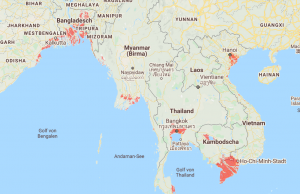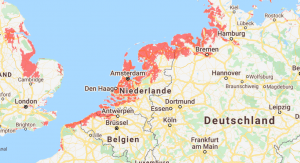Lina Bitterlin
The consequences of climate change are increasingly being felt. Temperatures are rising worldwide, the ice shields in the Artic are melting, forest are burning like in Australia this December and January. The list of urging consequences of the climate change seems endless. One of the most discussed consequences of climate change is the rising sea level, which is threatening the coastal population and their homes. By the cear 2050, aorund 300 million oeople will be affected by the rise of the oceans. Already today islands and coastal areas are influenced by the rising sea level and the sea is swallowing up more and more land and settlement areas . In the South Pacific five tiny islands have fallen victim to the sea. While rich countries have the captivity and the financial possibilities to protect the land from being erode by building dams people living in less privileged areas are often forced to give up their land and to leave their home.Sea Level rise far worse than previously expected
The melting ice caps are one reason for the rising sea levels, but the expansion of the water due to the increasing warming of the oceans is also a major contributory factor. According to the recent IPCC report an additional increase of the sea level of 0.30 to 1.10 meter can be expected by the year 2100 compared to the pre-industrial time. They have discovered that the sea level is rising much faster than expected. The calculations are based on a global warming simulation of two degress (Die Zeit, 2019)
Man has always tried to control nature and make it his subject, now the sea is taking gradually some land back. For us living in Switzerland, where there is no sea nearby it is difficult to imagine how land disappears in the sea.
But the disappearance of rather small islands is unfortunately already reality. According to Australian researchers, five islands have already fallen victim to the South Pacific. These five islands belonged to the Solomon Islands groups, which are laying north-east of Australia. The island were not just small sand islands but were up to five hectares in size, which is equivalent to more than five football fields. Luckily, these islands were not inhabited but six other islands which also belong to the Solomon Island groups are increasingly in danger .On one of those islands entire villages were destroyed and the inhabitants were forced to leave their home (The Guardian, 2016).
Climatchange is not fair
Climate Central is an independent group of scientists which is doing research on climate change and tries to understand how it affects people’s lives. They have built up an interactive card which is presenting the land projected to be below annual flood in level in 2050 (https://coastal.climatecentral.org/map/).The forecasts for sea-level rise are based on a digital calculation model called CoastalDEM, in which systematic errors are corrected using machine learning methods. So, the margin of error in the calculation of sea levels is at most about ten centimetres.
It is quite shocking seeing all the red coloured spots on the map, especially since the year 2050 is only 30 years away from us. The map clearly shows that large parts of Asia will be flooded by 2050. But also countries in Europe mainly the Netherlands and Germany are not spared.
The map also allows you to view a forecast up to the year 2100 and as you would expect, the map appears even redder. If not, drastic measures are taken, Venice will be flooded by 2100 at the latest. Already today Venice is struggling with regular floods that transform the lagoon city into a river system that is almost impassable for the inhabitants.

Figure 1: showing the flooded regions in Asia in 2050 (Climate Central, n.d)

Figure 2: showing the flooded regions in Germany and the Netherlands in 2050 (Climate Central, n.d)
The crucial difference lies in the fact that countries like Germany or the Netherlands have the necessary financial means to adapt to the new environmental conditions and take measures. A solution for Germany, the Netherlands and all the other North Sea and Baltic Sea countries would be to separate the Atlantic Ocean from the North sea by building a dam between France and England and another one between Scotland and Norway. A new study carried out by the Netherlands Institute of Oceanography shows that these measures would be technically feasible. The southern Dam would be 160 kilometres long and the northern with 480 kilometres is even longer (Frankfurter Rundschau, 2020)
Moreover, the study is also showing that this enormous project would be affordable. The researches estimate the costs at around 200 to 500 billion euros. Considering that 15 countries bordering the North and Baltic Sea would benefit from the two dikes and therefore also bear part of the costs, the countries could easily afford it. If a construction period of 20 years is assumed, only costs of 0.07 to 0.16 percent of their domestic product (DGP) were incurred per year (Frankfurter Rundschau, 2020)
Climate change is often not fair. The poorest regions, which have reasonably low Co2 balances are usually also the first to be affected. Around 70 % of the endangered people are living in eight Asian countries. Namely China, Bangladesh, India, Vietnam, Indonesia, Thailand, the Philippines and Japan. I strongly suspect that many of the listed states lack in money. Bangladesh is one of the poorest regions in the world and calculations are showing that Bangladesh will be most affected by the increase (Süddeutsche Zeitung, 2019).
But we should also consider that China which is producing worldwide the most Co2 is part of Asia and also India’s Co2 emissions are growing strongly. Both, India and China have so far refused to commit themselves to binding emission reductions. However, the poorer sections of the population are much more likely to be affected by the effects of climate change and have little influence on government policy.
The sea is threatening some of the Megacities in Asia especially Dhaka in Bangladesh, Manila in the Philippines and Jakarta in Indonesia. These are often the economic centre and there for crucial for the entire country. This makes the whole country more violable (Süddeutsche Zeitung, 2019)
On one hand, large areas of land for agriculture and settlements are lost, but on the other hand, there is a danger that the saltwater can seep into the groundwater. The risk of flooding is particularly high during the rainy season. The rivers are often very polluted and thus aggravate the waste problem in the settlements.
What needs to be done
There are possibilities and different measures to protect parts of the coastal zones, if the financial means, the technical knowledge and the political exists. The calculated values of science must be taken seriously and not played down. A worst-case scenario must be assumed, only then will the measures implemented be effective in the long term. The government should involve the population in the planning and provide them with truthful information. But all these measures only fight the symptoms and not the cause. The time window is very small to reduce global emissions to net zero, but this is the only way to avoid a wort case scenario and therefore the loss of many homes.
Even if many affected countries will build dams, we must unfortunately assume that many people will have to flee their homes due to climate change. But till now there is no legally binding definition for either environmental or climate refugees. One reason is that the Refugee Convention is designed to protect people who are persecuted. In the case of the climate crisis, the pursuer is difficult to define. The consequences of climate change affect us all and there is no one who is solely responsible. Often it is not the direct consequences of climate change that are the reason for flight, but the indirect consequences, such as crop failure or intensified political conflicts. In my opinion the conventions need to be rethought in order to cope with the current climate crisis. (Utopia, 2020)
Interesting aricle about the sinking city Jakarta
https://www.nzz.ch/international/indonesien-hauptstadt-jakarta-droht-im-meer-zu-versinken-ld.1399833
References
Zeit Online (2019) Die Flut von Morgen. Retrieved from https://www.zeit.de/2019/40/meeresspiegel-anstieg-wasserstand-klimaschutz-weltklimarat, on 3.04.2020
The Guardian (2016) Five Pacific island lost to rising seas as climate change hits. Retrieved from https://www.theguardian.com/environment/2016/may/10/five-pacific-islands-lost-rising-seas-climate-change on 3.04.2020
Frankfurter Rundschau (2020). Mauer um die Nordsee. Retrieved from https://www.fr.de/wirtschaft/mauer-nordsee-13551370.html on 3.04.2020
Süddeutsche Zeitung (2019). Anstieg der Meere bedroht 300 Millionen Menschen. Retrieved from https://www.sueddeutsche.de/wissen/meeresspiegel-anstieg-klimawandel-pole-1.4662548 0n 4.04.2020
Utopia (2020). Klimaflüchtlinge: Wenn der Klimawandel zum Fluchtgrund wird. Retrieved from: https://utopia.de/ratgeber/klimafluechtlinge-wenn-der-klimawandel-zum-fluchtgrund-wird/
Media Atributions:
Climate Central (n.d).Coastal Risk Screening Tool Retrieved from (https://coastal.climatecentral.org/map/) on 4.04.2020
Media Attributions
- Blogg Bild 2
- Blogg Bild 1